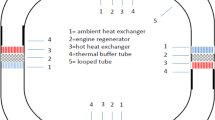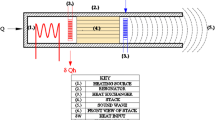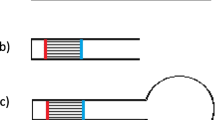Abstract
An acoustic pressure amplifier (APA) is capable of improving the match between a thermoacoustic engine and a load by elevating pressure ratio and acoustic power output. A standing-wave thermoacoustic engine driving a resistance-and-compliance (RC) load through an APA was simulated with linear thermoacoustics to study the impact of load impedance on the performance of the thermoacoustic system. Based on the simulation results, analysis focuses on the distribution of pressure amplitude and velocity amplitude in APA with an RC load of diverse acoustic resistances and compliance impedances. Variation of operating parameters, including pressure ratio, acoustic power, hot end temperature of stack, etc., versus impedance of the RC load is presented and analyzed according to the abovementioned distribution. A verifying experiment has been performed, which indicates that the simulation can roughly predict the system operation in the fundamental-frequency mode.
Similar content being viewed by others
References
Arman, B., Wollan, J.J., Swift, G.W., Backhaus, S., 2003. Thermoacoustic Natural Gas Liquefiers and Recent Developments. Cryogenics and Refrigeration, Proceedings of ICCR’2003, p. 123–127.
Bao, R., Chen, G.B., Tang, K., Cao, W.H., Jin, T., 2006a. Thermoacoustically driven pulse tube refrigeration below 80 K by introducing an acoustic pressure amplifier. Applied Physics Letters, 89(21):211915. [doi:10.1063/1.2387939]
Bao, R., Chen, G.B., Tang, K., Jia, Z.Z., Cao, W.H., 2006b. Effect of RC load on performance of thermoacoustic engine. Cryogenics, 46(9):666–671. [doi:10.1016/j.cryogenics.2006.04.002]
Dai, W., Luo, E.C., Hu, J.Y., Chen, Y.Y., 2005. A novel coupling configuration for thermoacoustically-driven pulse tube coolers: Acoustic amplifier. Chinese Science Bulletin, 50(18):2112–2114. [doi:10.1360/982005-482]
Duthil, P., Baltean Carlès, D., Bétrancourt, A., François, M.X., Yu, Z.B., Thermeau, J.P., 2006. Experiments and valve modeling in thermoacoustic device. Advances in Cryogenic Engineering, 51(B):1095–1102.
Hu, J.Y., Luo, E.C., Dai, W., Zhou, Y., 2007. A heat-driven thermoacoustic cryocooler capable of reaching below liquid hydrogen temperature. Chinese Science Bulletin, 52(4):574–576. [doi:10.1007/s11434-007-0104-5]
Matsubara, Y., Dai, W., Onishi, T., Kushino, A., Sugita, H., 2003. Thermally Actuated Pressure Wave Generators for Pulse Tube Cooler. Cryogenics and Refrigeration, Proceedings of ICCR’2003, p.57–60.
Nguyen, C.T., Yeckley, A.J., Schieb, D.J., Haberbusch, M.S., 2004. Hydrogen/oxygen propellant densifier thermoacoustic Stirling heat engine. Advances in Cryogenic Engineering, 49(B):1703–1709.
Swift, G.W., 2002. Thermoacoustics: A Unifying Perspective for Some Engines and Refrigerators. Acoustical Society of America Publications, Sewickley, PA.
Tang, K., Chen, G.B., Kong, B., 2004. A 115 K thermoacoustically driven pulse tube refrigerator with low onset temperature. Cryogenics, 44(5):287–291. [doi:10.1016/j.cryogenics.2003.12.004]
Tang, K., Chen, G.B., Jin, T., Bao, R., Kong, B., Qiu, L.M., 2005. Influence of resonance tube length on performance of thermoacoustically driven pulse tube refrigerator. Cryogenics, 45(3):185–191. [doi:10.1016/j.cryogenics.2004.10.002]
Tang, K., Chen, G.B., Jin, T., Bao, R., Li, X.M., 2006. Performance comparison of thermoacoustic engines with constant-diameter resonant tube and tapered resonant tube. Cryogenics, 46(10):699–704. [doi:10.1016/j.cryogenics.2006.04.006]
Tang, K., Bao, R., Chen, G.B., Qiu, Y., Shou, L., Huang, Z.J., Jin, T., 2007. Thermoacoustically driven pulse tube cooler below 60 K. Cryogenics, 47(9–10):526–529. [doi:10.1016/j.cryogenics.2007.04.003]
Yu, G.Y., Luo, E.C., Dai, W., Wu, Z.H., 2007. An energyfocused thermoacoustic-Stirling heat engine reaching a high pressure ratio of 1.40. Cryogenics, 47(2):132–134. [doi:10.1016/j.cryogenics.2006.12.001]
Author information
Authors and Affiliations
Corresponding author
Additional information
Project supported by the National Natural Sciences Foundation of China (No. 50536040), the University Doctoral Subject Special Foundation of China (No. 20050335047), the Postdoctoral Science Foundation of Zhejiang Province (No. 2006-bsh-21), and the Natural Science Foundation of Zhejiang Province (No. Y107229), China
Rights and permissions
About this article
Cite this article
Tang, K., Huang, Zj., Jin, T. et al. Impact of load impedance on the performance of a thermoacoustic system employing acoustic pressure amplifier. J. Zhejiang Univ. Sci. A 9, 79–87 (2008). https://doi.org/10.1631/jzus.A071340
Received:
Accepted:
Published:
Issue Date:
DOI: https://doi.org/10.1631/jzus.A071340




